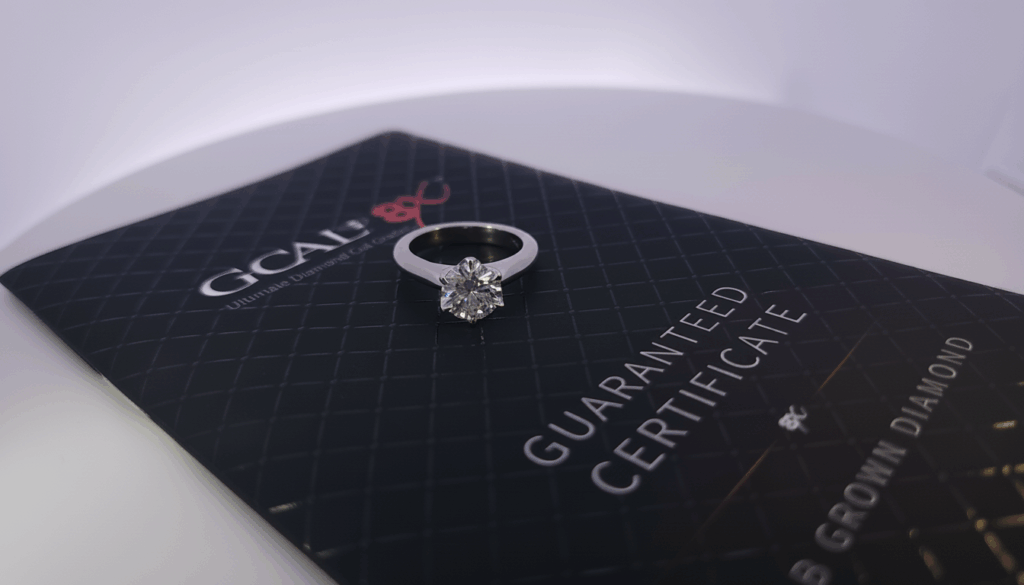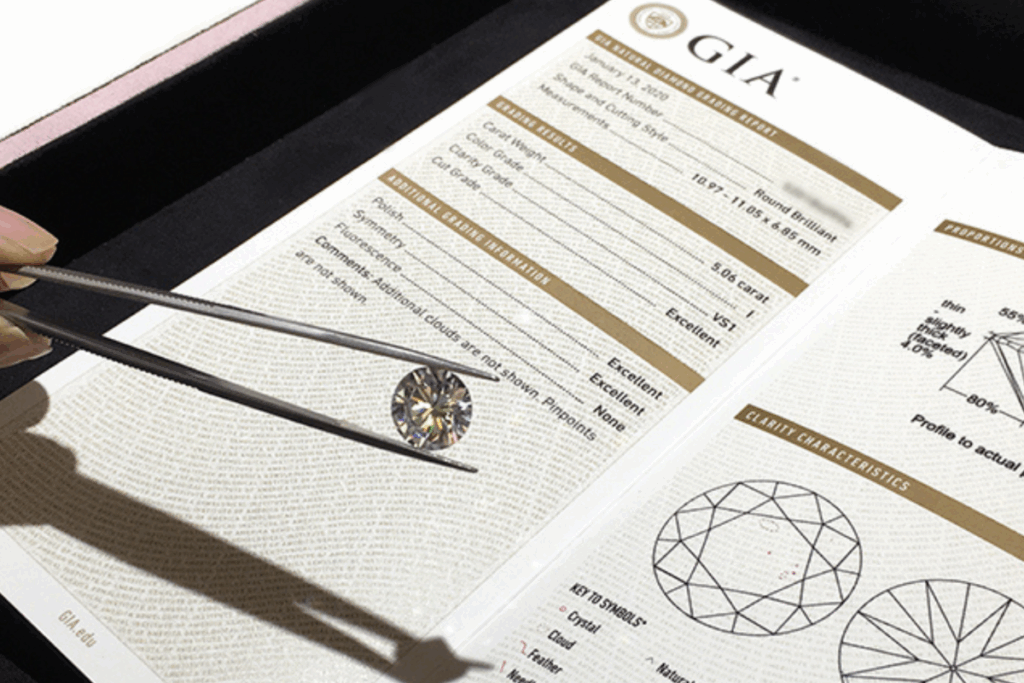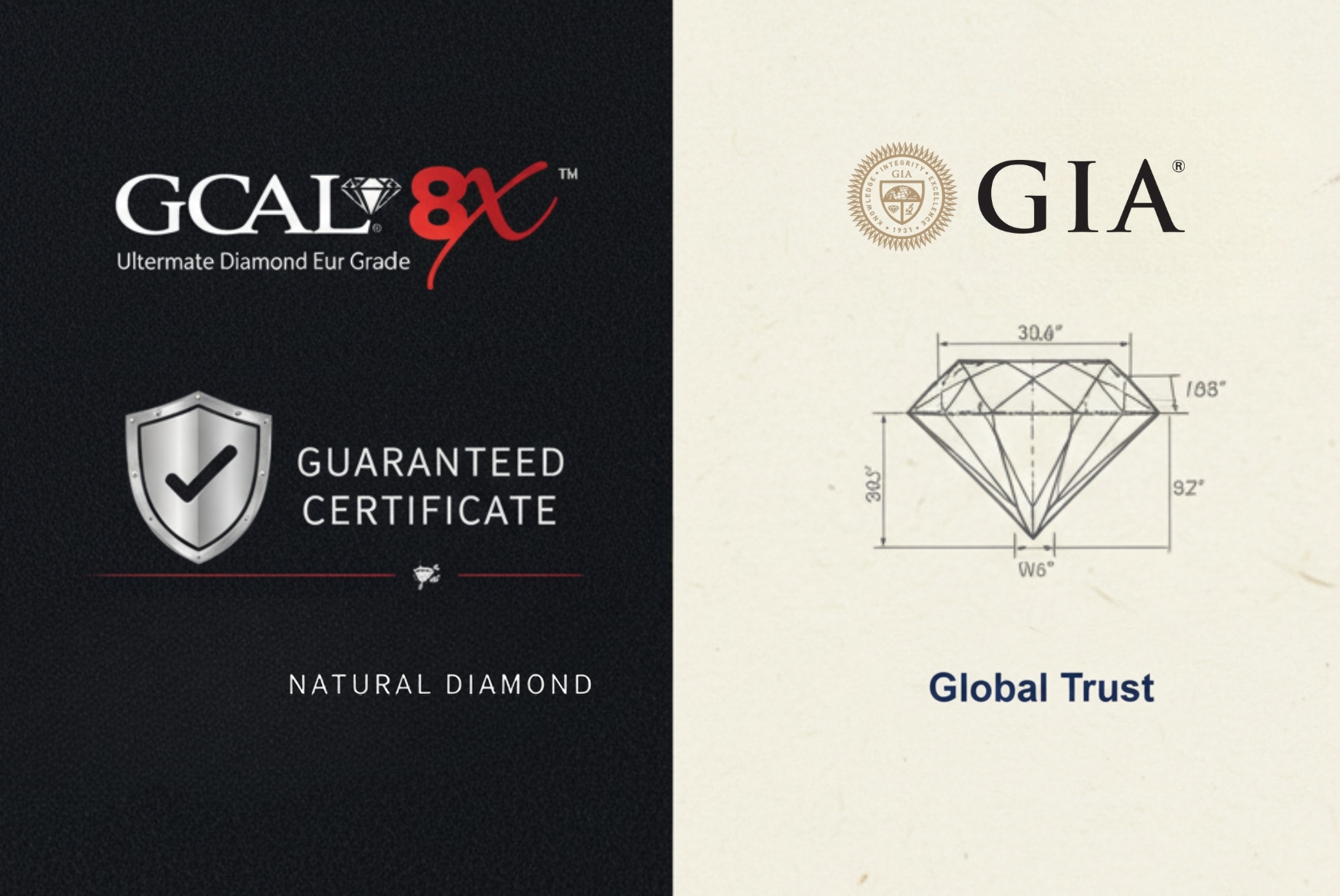GCAL vs GIA: Key Differences Every Buyer Should Know
When you want to buy a diamond, you need to be sure about the quality. The first thing to do is look for a jeweler you can trust. The next step is to get a report from a certified diamond lab. This report from the lab helps you check if what the seller said is true. The diamond grading process lets you compare diamonds with others. You can know their real details by doing this. Some of the best labs for diamond certification are GCAL and GIA. You should know how they grade diamonds and their different grading standards if you want to make an informed decision.
Understanding Diamond Certification Labs
Diamond certification labs are groups that check and grade diamonds. They examine various aspects, including cut, color, clarity, and carat weight. The lab uses steps that do not change from one stone to the next. After checking the diamond, they give you a paper that shows the diamond’s quality. This gem certification helps you trust that your stone is real and worth what you pay.
People often use the word “diamond certificate.” But most labs give “grading reports.” These reports are what the experts from the grading lab think. They give a guaranteed diamond certificate, not just an opinion. If you want to buy an important diamond, it is good to get a report from a respected certification lab.
What Is GCAL?

The Gem Certification & Assurance Lab, called GCAL, started in 2001. Donald Palmeiri founded it, and its only location is in New York City. This lab may have just one place, but GCAL has built a good reputation in the diamond industry for strong grading standards and great precision.
It works with natural diamonds, lab-grown diamonds, and a variety of jewelry types. GCAL is recognized for its special 8X® grading system. This grading system does more than look at just the shape or size. It studies eight different parts of cut quality.
Some of these include a diamond’s optical brilliance, its fire, and how it sparkles, known as scintillation. By doing this, GCAL gets a full picture of how the diamond deals with light.
GCAL also has ISO 17025 accreditation, which is a well-known international standard. This shows the lab’s focus on quality in its tests and makes sure they do things right every time. Getting this gem certification proves the lab’s promise of accuracy and trust. That is why people in the diamond industry trust this assurance lab in New York City.
What Is GIA?

The Gemological Institute of America (GIA) is known by many people as the top name in gemology all over the world. The group started in 1931. In 1953, it came up with the 4Cs and the International Diamond Grading System™. This grading system is now used by almost every grading lab and is seen as the gold standard for diamond grading.
GIA has labs across the world. It is known for its strong grading process, being fair, and always doing things right. A GIA certification is the most trusted in the diamond industry. Many jewelers and buyers choose GIA because they want a grading lab that is honest and pays a lot of attention to research. This big role makes the GIA’s grading system stand out over others.
GIA works hard on tools that check if the diamonds are natural diamonds and to tell if they are not real. The group has global recognition. Because of this, a diamond with GIA certification and a report from the Gemological Institute of America is known and valued around the world. These reports are often what people look at to judge the quality of a certified diamond.
How GCAL and GIA Approach Diamond Grading
Both groups work hard to give accurate diamond grading. GIA is known for its conservative grading. It has set the industry benchmark for color and clarity. The grading system of GIA is the basis of the modern diamond market.
GCAL is different. This group focuses more on having a detailed look at a diamond’s cut grade and how it handles light performance. GCAL uses a unique 8X® grading system and has a consumer guarantee. These give a new kind of trust to people looking for diamonds. If you want to understand diamond grading better, knowing about these grading standards and systems can help you read both GIA and GCAL reports with more confidence.
GCAL vs GIA: Grading Processes Side by Side
The diamond evaluation process for both labs is rigorous, but the final grading report highlights their different philosophies. A GIA report delivers a trusted, standard assessment of the 4Cs, including a plotted diagram of inclusions for identification. It is the model of consistency in the diamond industry.
A GCAL report includes the 4Cs but adds extensive data on light performance, optical symmetry, and even a “fingerprint” of the diamond. The most significant difference is that GCAL’s report is a guaranteed certificate, whereas GIA’s is a report of opinion. Each report number can be verified online for authenticity.
Here is a side-by-side look at what sets them apart:
| Feature | GCAL (Gem Certification & Assurance Lab) | GIA (Gemological Institute of America) |
|---|---|---|
| Primary Focus | Cut quality, light performance, and guaranteed grading accuracy. | Setting the industry standard for Color and Clarity grades. |
| Unique Feature | “Zero Tolerance” guarantee on grading results. | Unmatched global recognition as the “gold standard.” |
| Cut Grade System | Detailed 8X® system assessing eight aspects of cut. | “Excellent” cut grade; optional AGS Ideal report addendum. |
| Report Type | Issues a guaranteed “Certificate” with financial backing. | Issues a “Grading Report,” which is a professional opinion. |
Technology, Tools, and Methodologies Used
GCAL uses the latest technology for advanced graphical analyses in its grading system. The unique 8X® grading system from GCAL gives a deep look into a diamond’s visual performance, which is not something you get from every lab. Light performance analysis is a key part of how they work.
GCAL’s grading system looks at things that affect a diamond’s beauty, like:
- Optical Brilliance and Fire
- Scintillation
- Optical Symmetry and Hearts & Arrows patterns
GIA is known for being a leader in gem tools. It uses strong technology, especially for finding lab-grown diamonds and checking where they come from. GIA works with the old AGS to bring AGS’s ASET light performance analysis to its reports. This means buyers get extra information about cut quality, especially for ideal cut diamonds.
Reputation, Recognition, and Trust in the Diamond Industry
A grading lab’s reputation is just as important as how it checks diamonds. The trust that buyers and stores have in a diamond certificate affects how much the stone is worth. It also affects how much people want it. When you buy a certified diamond, you are getting the trust that comes with the grading lab that checked it.
GIA has built long-lasting trust over many years. It sets the standard for global recognition. GCAL has also made a name for itself by using very strict grading standards. It stands out because it gives a consumer guarantee. Let’s look at how each grading lab is seen in the market.
GCAL’s Standing Among Buyers and Retailers
GCAL is a well-known lab in the diamond industry. It works out of one place in New York City. Even though it does not have offices all over the world like GIA, it has become a preferred choice because it pays close attention to details.
Many people and big chain jewelry stores like Gcal Diamonds go for Gcal certification. They do this because they want to demonstrate to their customers that they are transparent and honest about what they sell. This extra step in testing helps customers feel sure about buying.
The lab uses data that can be checked and has strong financial support behind it. This lets people buying diamonds feel good and trust the lab. As a result, GCAL has established a strong reputation with buyers and gained a notable presence in the market. Its focus is great for those who really care about things like how a diamond is cut or how much it sparkles.
GIA’s Global Recognition and Influence
The Gemological Institute of America is known as the top diamond grading group in the world. People trust it more than any other. Its name stands for honesty. When you get a GIA certificate, it is known as the gold standard for diamond grading.
If you have the most important diamonds, a GIA report is the document people trust all over the globe. This kind of global recognition builds strong confidence. When you buy or sell a diamond with a GIA certificate, you know the diamond was checked using the strictest standards in the industry. This is what gives the Gemological Institute of America so much influence.
Because people see the GIA name as the top choice, diamonds with GIA grading often sell for a higher price. They also hold value better if you decide to sell them. A GIA certificate acts like the benchmark for quality and value in diamond grading in every market that uses the gold standard.
Comparing Accuracy and Consistency
When you buy a diamond, you want to be sure that the grade shown on the certificate is right for the stone you get. The grading lab should give accurate and steady results. GIA is well known for its conservative grading. GCAL is also seen as a trusted choice because of its accuracy.
Still, each grading lab may help you differently if there is a mistake or if the grade is too high. Let’s see which grading lab gives more reliable grades and how they can help you keep your investment safe.
Which Lab Offers More Reliable Grades?
Both GCAL and GIA are trusted for giving honest grades. Many people in the industry say that GIA sets the standard for conservative grading. You can count on it to be tough and steady, especially for things like color and clarity. People rarely question if a GIA report is right.
Most in the industry believe that GCAL’s grading standards match GIA for the main 4Cs. This helps make sure the process to check the diamond is repeatable and accurate. There is a strong objective assessment of a diamond because of these steps.
The reliability depends on what matters most to you. GIA is the top pick for a score everyone accepts as tough and fair. GCAL gives you a grade with a financial guarantee and a deep check of cut quality, so it offers great reliability, too.
Overgrading Risks and Consumer Protections
One big risk when you buy a diamond is “overgrading.” This happens when a lab gives the diamond a better grade than it should. You could pay too much because of this mistake. The best labs help protect you from this problem.
GCAL gives strong consumer protection with its consumer guarantee. It has:
- A “Zero Tolerance” cash-back plan.
- Financial assurances if another top lab finds the diamond grade is wrong.
GIA does not offer a money-redo guarantee. Instead, it protects you through its very strong name and conservative grading. People all over the world trust GIA reports. The market sees these reports as honest and correct.
Financial assurances and conservative grading are used to give you safety when buying. GCAL and GIA both work in their own way to keep you safe as a buyer. Consumer guarantee from GCAL gives you something different that you may want when looking for a high-quality diamond.
Value, Pricing, and Resale Implications
The diamond certificate that comes with a stone does more than show how good it is. It also has a big effect on the price and makes selling the diamond easier later on. What people think about different grading labs can change how much a certified diamond costs. A diamond with a certificate from a top lab looks safer to buy.
The worth of the diamond depends on how much the next owner trusts its diamond certificate. Below, we look at how a GCAL or GIA report can change the price of a certified diamond and what that means for diamond owners. This also helps us see if owning one is good in the long term.
Market Perceptions and Resale Ease
When people think about diamond grading, GIA stands out. GIA is known as the top authority around the world. A GIA diamond certificate is also trusted everywhere. Many people know that a diamond certificate from GIA is the best and most accepted report in the market. Because of this, a GIA-certified diamond is easy to sell, making it a good asset.
This trust helps a lot when you go to sell your engagement ring or a certified diamond. If it has a GIA certificate, it is much easier to find a buyer, and you can often get a higher price for it. Buyers and jewelers usually want to see a GIA certificate before they buy a diamond or make a big purchase.
GCAL is also known for its accurate grading and promise, but it is not as famous as GIA across the world yet. It might be harder to sell a diamond with only a GCAL report. You may need to find people who fully understand and want the special details inside a GCAL diamond certificate.
Price Differences for GCAL vs GIA Certified Diamonds
There is often a big price gap when you look at diamonds that are certified by GIA and those checked by other grading labs. The price is not just about how much the certificate costs. It comes from the trust and value people place on the grading lab itself.
Most of the time, a certified diamond that comes with a GIA report will sell for more money than a similar one with a report from another lab. Buyers usually want to pay extra to get the peace of mind and trust that GIA brings. This is why GIA is seen as the top choice when talking about the market value of diamonds.
When you want to compare prices for a certified diamond, keep these things in mind:
- A certified diamond with a GIA grade is often at the high end of the market when it comes to price.
- A GCAL-graded diamond could seem like it offers more value if its price is less than a GIA diamond that looks the same on paper.
- Always put diamonds graded by the same grading lab side by side. This will help you get a fair and true comparison when looking at price.
FAQs
Should I choose a GCAL or GIA certificate when buying a diamond?
What you pick will be based on your personal preferences. Go with a GIA certification for grading standards, global recognition, and good resale value. Pick a GCAL certificate if you care more about a close look at the cut, and want clear details and the peace of mind from a financial guarantee on the grading standards.
Can I trust a GCAL certificate as much as a GIA certificate?
Yes, GCAL is a well-known assurance lab. It has an ISO certificate and gives a special consumer guarantee with each grading report. GIA may be the industry standard, but GCAL is also trusted. The lab’s focus on accuracy and the strong security features help make every certified diamond report from GCAL very reliable.
What should I check for on a GCAL or GIA certificate?
Always check the report number of the diamond online with the lab. Take a close look at the 4Cs, and focus on the cut grade. Check if there are any inclusion plots or diagrams. If you are looking at a GCAL certificate, also check the light performance info. For natural diamonds, make sure the certificate shows full disclosure.

